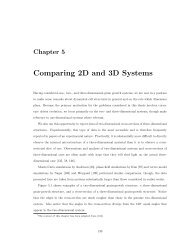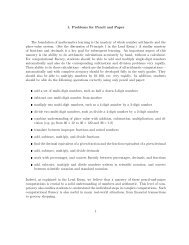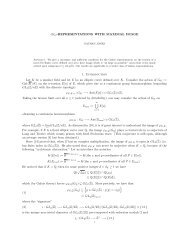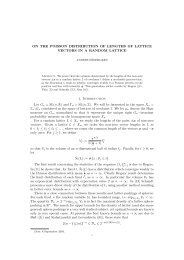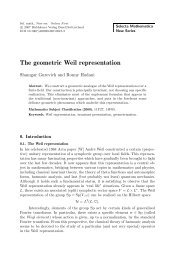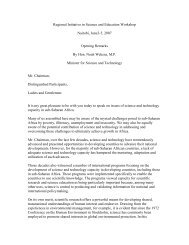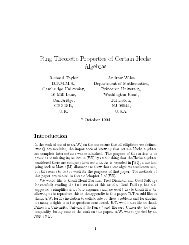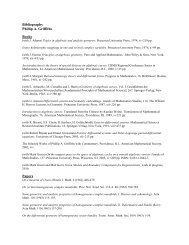Create successful ePaper yourself
Turn your PDF publications into a flip-book with our unique Google optimized e-Paper software.
12 MAKSYM RADZIWI̷L̷L<br />
Lemma 7. Let Ψ(·) be a distribution function. Let f be a positive strongly additive function.<br />
Suppose that 0 f(p) O(1) for all primes p. Let<br />
K f (x; t) :=<br />
1<br />
B 2 (f; x)<br />
∑<br />
p x<br />
f(p) t<br />
If K f (x; t) − Ψ(t) ≪ 1/B 2 (f; x) uniformly in t ∈ R, then<br />
f(p) 2<br />
ρ Ψ (B(f; x); ∆) − η f (x; ∆) = o(1/B 2 (f; x))<br />
uniformly in 1 ∆ o(B(f; x)). The symbols ρ Ψ (B(x); ∆) and η f (x; ∆) are defined in<br />
lemma 6 and lemma 5 respectively.<br />
Proof. Let η = η f (x; ∆). Recall that by lemma 5, η = o(1) in the range 1 ∆ o(B(f; x)).<br />
This will justify the numerous Taylor expansions involving the parameter η. With K f (x; t)<br />
defined as in the statement of the lemma, we have<br />
(15)<br />
∑<br />
px<br />
f(p)e ηf(p)<br />
p<br />
− µ(f; x) = ∑ f(p)(e ηf(p) − 1)<br />
p<br />
px<br />
∫<br />
= B 2 e ηt − 1<br />
(f; x) dK f (x; t)<br />
R t<br />
Let M > 0 be a real number such that 0 f(p) M for all p. Since the f(p) are bounded,<br />
for each x > 0 the distribution function K f (x; t) is supported on [0; M]. Furthermore since<br />
K f (x; t) → Ψ(t) the distribution function Ψ(t) is supported on exactly the same interval.<br />
From these considerations, it follows that<br />
∫<br />
e ηt ∫<br />
− 1<br />
M<br />
e ηt − 1<br />
dK f (x; t) =<br />
dK f (x; t)<br />
(16)<br />
=<br />
R<br />
∫ M<br />
0<br />
t<br />
e ηt − 1<br />
dΨ(t) +<br />
t<br />
∫ M<br />
0<br />
p<br />
0 t<br />
(<br />
Kf (x; t) − Ψ(t) ) [ ]<br />
e ηt − ηt · e ηt − 1<br />
· dt<br />
t 2<br />
By a simple Taylor expansion e ηt − ηt · e ηt − 1 = O(η 2 t 2 ). Therefore the integral on the right<br />
hand side is bounded by O(η 2 /B 2 (f; x)). We conclude from (15) and (16) that<br />
∑ f(p)e ηf(p)<br />
∫<br />
(17)<br />
− µ(f; x) = B 2 e ηt − 1<br />
(f; x) dΨ(t) + O ( η 2)<br />
p<br />
t<br />
px<br />
By definition of ρ Ψ and η f ,<br />
∫<br />
(18) B 2 e ρΨ(B;∆)t − 1<br />
(f; x)<br />
dΨ(t) = ∆B(f; x) = ∑ f(p)e η f (x;∆)f(p)<br />
− µ(f; x)<br />
R t<br />
p<br />
px<br />
From (17) and (18) it follows that<br />
∫<br />
(19) B 2 e ρΨ(B;∆)t − e η f (x;∆)t<br />
(f; x)<br />
dΨ(t) = O ( η 2<br />
t<br />
f(x; ∆) )<br />
R<br />
Since Ψ(t) is supported on [0; M] we can restrict the above integral <strong>to</strong> [0; M]. By lemma 5,<br />
we have η f (x; ∆) ∼ ∆/B(f; x) = o(1) in the range ∆ o(B(f; x)). Also 0 ρ Ψ (x; ∆) <br />
R



